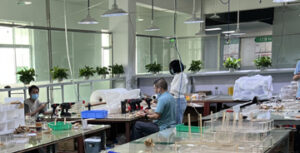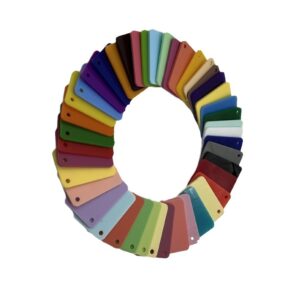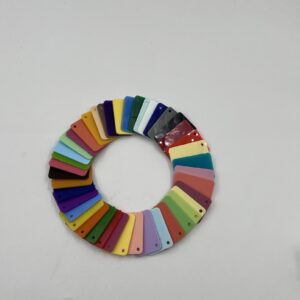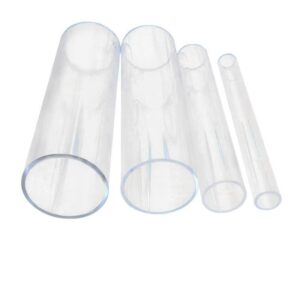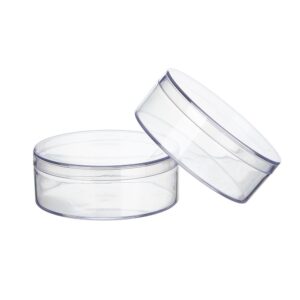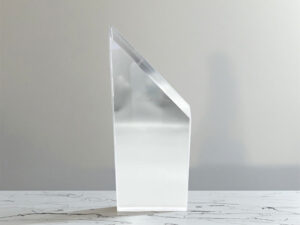Dans le monde du merchandising visuel et de la présentation des produits, le support est aussi crucial que le message. Depuis des décennies, le défi consiste à trouver un matériau capable de présenter un objet avec une clarté parfaite et discrète, tout en le protégeant, en résistant aux rigueurs d'un environnement public et en s'adaptant aux exigences en constante évolution du design. Si le verre a toujours été la solution par défaut, un matériau de qualité supérieure a depuis longtemps conquis le trône : l'acrylique.
Souvent connu sous des noms commerciaux tels que Plexiglas ou Perspex, l'acrylique (plus précisément le poly(méthacrylate de méthyle) ou PMMA) n'est pas simplement une alternative “plastique” au verre. Il s'agit d'un polymère technique, une merveille de la science des matériaux qui surpasse son prédécesseur dans presque tous les domaines significatifs. Cet essai se penche sur les fondements scientifiques et techniques qui permettent au PMMA d'être une alternative au verre. Présentoirs en acrylique le choix sans équivoque pour tous ceux qui souhaitent mettre en valeur des produits, des œuvres d'art ou des artefacts. Nous irons au-delà des simples points de repère et explorerons la structure moléculaire, la physique optique et les principes d'ingénierie qui confèrent à l'acrylique ses propriétés remarquables. Du bijoutier haut de gamme au conservateur de musée, du détaillant avisé au collectionneur amateur, la compréhension de l'acrylique est essentielle. pourquoi L'acrylique est meilleur est la première étape pour tirer parti de tout son potentiel.
Table des matières
La science de la vision : Une clarté optique inégalée
La fonction première de tout présentoir est d'être invisible - de permettre au spectateur de voir l'objet qu'il contient, et non le matériau qui l'enveloppe. À cet égard, les performances optiques de l'acrylique ne sont pas seulement bonnes, elles sont exceptionnelles.
Transmission de la lumière : Plus qu'un simple coup d'œil
La clarté est mesurée scientifiquement par la transmission de la lumière, c'est-à-dire le pourcentage de lumière qui peut traverser un matériau. Le verre plat standard, qui présente souvent une légère teinte verte ou bleue due aux impuretés d'oxyde de fer, transmet généralement entre 83% et 90% de lumière visible. Le verre “blanc d'eau” de haute qualité, à faible teneur en fer, peut améliorer ce résultat, mais il est vendu à un prix élevé.
Qualité standard présentoir en acrylique en revanche, affiche un taux de transmission de la lumière de 92%. Cette différence peut sembler mineure, mais l'impact visuel est profond. Cette clarté supérieure signifie que les couleurs sont plus éclatantes et plus vraies que nature. Les détails sont plus nets. L'ensemble de la présentation semble plus lumineux et plus attrayant, car davantage de lumière atteint à la fois l'objet et l'œil du spectateur. Pour un détaillant vendant des montres de luxe aux cadrans complexes ou pour une galerie exposant une aquarelle aux nuances subtiles, cette différence de lumière de 2-10% fait la différence entre une bonne présentation et une présentation parfaite. C'est la raison pour laquelle les objets placés dans un boîtier en acrylique semblent “ressortir” avec plus de vie et de dimension.
L'indice de réfraction et son importance
Une autre propriété optique essentielle est l'indice de réfraction, qui mesure à quel point un matériau dévie la lumière. L'acrylique a un indice de réfraction d'environ 1,49, ce qui est très proche de celui du verre crown (environ 1,52). Cette similitude signifie qu'il ne crée pas de distorsion visuelle importante. Cependant, le véritable avantage réside dans le processus de fabrication. L'acrylique peut être coulé et poli à un degré de perfection optique beaucoup plus élevé que le verre sur de grandes surfaces, ce qui minimise les imperfections internes susceptibles de provoquer de légères distorsions ou des reflets. Le résultat est une vue nette et ininterrompue sous presque tous les angles.
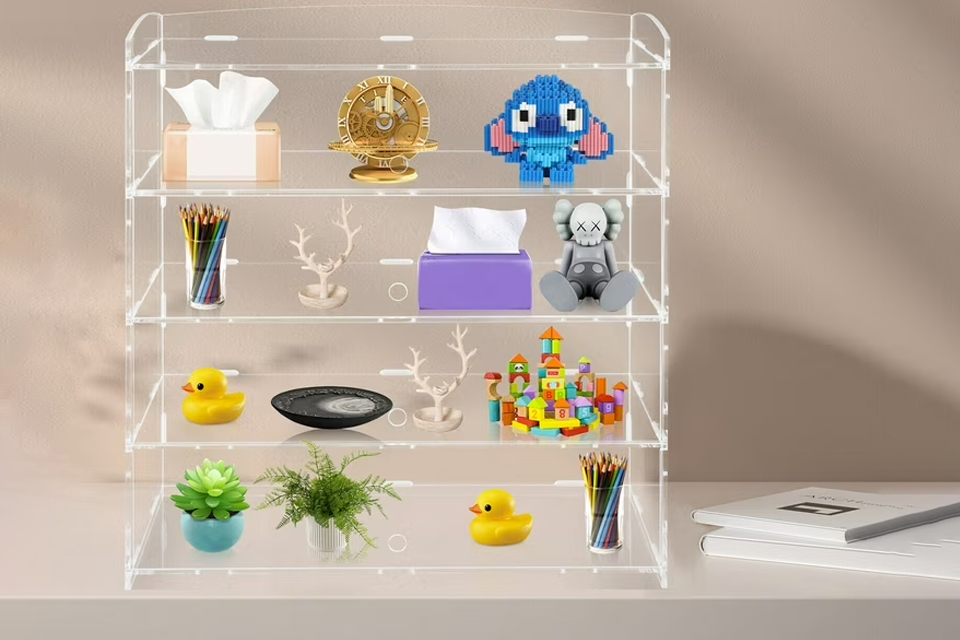
Résistance à l'effet de jaunissement : stabilité intégrée aux UV
Les plastiques ont souvent tendance à jaunir ou à se fragiliser avec le temps, en particulier lorsqu'ils sont exposés à la lumière du soleil. Cette crainte est justifiée pour les polymères de moindre qualité, mais pas pour l'acrylique de haute qualité. Le PMMA est intrinsèquement stable contre le rayonnement ultraviolet (UV). Les liaisons moléculaires au sein du polymère ne sont pas facilement rompues par l'énergie des rayons UV.
Les fabricants de feuilles acryliques de qualité supérieure renforcent souvent cette résistance naturelle en ajoutant des stabilisateurs UV au cours de la production. Cela permet de garantir qu'un vitrine acrylique conservera sa clarté cristalline pendant une décennie ou plus, même dans une vitrine éclairée par le soleil ou sous l'éclairage intense d'une galerie. Le verre ne jaunit pas, mais il ne bloque pas non plus intrinsèquement les rayons UV, à moins d'être spécialement traité avec des revêtements coûteux. Une vitrine acrylique standard offre donc un double avantage : elle reste transparente tout en protégeant les objets exposés - qu'il s'agisse d'un manuscrit inestimable ou d'un tissu éclatant - de la décoloration et de la dégradation causées par l'exposition aux UV.
Construit pour durer : l'ingénierie de la durabilité et de la sécurité
Si la clarté optique attire d'abord le regard, c'est la solidité et la sécurité sous-jacentes de l'acrylique qui en font le choix le plus pratique et le plus responsable pour la quasi-totalité des environnements. Cette durabilité n'est pas magique ; elle est le résultat direct de son ingénierie moléculaire.
Résistance à l'impact : L'avantage moléculaire
Pour comprendre pourquoi l'acrylique est si résistant, il faut examiner sa structure. Le verre est un solide amorphe dont la structure atomique est rigide et étroitement liée. Lorsqu'il est soumis à un choc violent, l'énergie ne peut aller nulle part. Les liaisons se brisent et la fissure se propage presque instantanément à l'ensemble de la vitre.
L'acrylique, en revanche, est un polymère. Sa structure est composée de longues chaînes de molécules enchevêtrées. Il s'agit en quelque sorte d'un filet composé de cordes microscopiques. Lorsqu'un objet heurte une feuille d'acrylique, l'énergie de l'impact est absorbée et répartie le long de ces chaînes de polymères flexibles. Elles peuvent s'étirer et se déformer légèrement pour dissiper la force sans se rompre.
La différence de performance est stupéfiante. Selon son épaisseur et sa qualité, l'acrylique peut être de 10 à 24 fois plus résistant aux chocs qu'une plaque de verre standard de même épaisseur. Il ne s'agit pas d'un simple chiffre, mais d'un changement fondamental dans la fiabilité des matériaux. Un choc accidentel avec un chariot de supermarché, la chute d'un outil lors de l'installation ou un coup de coude malencontreux dans un stand d'exposition bondé peuvent briser une vitrine, créant un désordre dangereux et coûteux. Un présentoir en acrylique Dans la plupart des cas, il absorberait simplement le coup et resterait intact. Ce niveau de résistance est validé par des tests standardisés, tels que ceux définis par le ASTM International, qui quantifient la capacité du matériau à résister aux chocs.
| Fonctionnalité | Acrylique (PMMA) | Verre standard | Polycarbonate |
|---|---|---|---|
| Clarté optique | Excellent (transmission de la lumière 92%) | Bonne (transmission 83-90%) | Bon (transmission 88%) |
| Résistance aux chocs | Haut (10-24x plus fort que le verre) | Faible (fragile) | Extrêmement élevé (250x plus fort) |
| Poids (par rapport au verre) | Briquet ~50% | Base de référence | Briquet ~50% |
| Résistance aux UV | Excellent (naturellement résistant) | Médiocre (transmet les UV à moins d'être revêtu) | Médiocre (jaune sans revêtement) |
| Résistance aux rayures | Bon (peut être rayé mais facilement poli) | Excellent | Médiocre (se raye facilement) |
| Fabrication | Excellent (facile à couper, à plier, à coller) | Difficile (nécessite des outils spéciaux) | Bon (peut être difficile à coller) |
| Coût | Modéré | Faible à modéré | Haut |
Remarque : le polycarbonate est inclus en tant qu'alternative au “plastique transparent”. Bien qu'il soit incroyablement solide, sa faible résistance aux rayures et sa tendance à jaunir en l'absence d'une couche dure protectrice le rendent moins adapté aux écrans haut de gamme pour lesquels la perfection visuelle est primordiale.
Une conception incassable : Une alternative plus sûre
Le plus grand inconvénient du verre est la façon dont il se brise. Il se brise en éclats dangereux et tranchants comme des lames de rasoir. Cela représente un risque important de blessure dans tout espace public, en particulier dans les environnements où se trouvent des enfants, comme les écoles ou les musées, ou dans les magasins de détail très fréquentés. Un présentoir en verre brisé n'est pas seulement une perte de produit et d'installation ; c'est un risque pour la sécurité qui nécessite un nettoyage immédiat et minutieux et qui peut engager la responsabilité juridique de l'entreprise.
L'acrylique, lorsqu'il est soumis à une force extrême, se fissure ou se brise généralement en quelques gros morceaux aux arêtes émoussées. Il ne se brise pas en une pluie de fragments tranchants. Cette qualité “incassable” en fait un matériau infiniment plus sûr. Pour les conservation des musées Les vitrines en acrylique sont devenues la norme dans le secteur de la conception d'expositions, où la sécurité des visiteurs et du personnel n'est pas négociable. Ce profil de sécurité est tout aussi précieux dans un environnement commercial, car il protège à la fois les clients et les employés.
Le rapport poids/force
Un dernier aspect crucial de l'ingénierie de l'acrylique est sa densité. La densité de l'acrylique est inférieure de moitié à celle du verre. Un panneau de verre de 1/4″ d'épaisseur pèse environ 3,2 livres, alors que le même panneau d'acrylique ne pèse que 1,6 livre.
Cette réduction de poids de la 50% a des effets bénéfiques massifs en cascade.
- Frais d'expédition : Les présentoirs plus légers sont moins coûteux à transporter du fabricant au magasin ou au hall d'exposition.
- Installation : Une grande vitrine en acrylique peut souvent être manipulée et installée par une ou deux personnes, alors qu'une vitrine en verre comparable peut nécessiter une équipe spécialisée et du matériel de levage.
- Exigences structurelles : Les étagères murales, les enseignes suspendues et les grandes vitrines autoportantes fabriquées en acrylique sollicitent beaucoup moins les murs, les plafonds et les sols. Cela peut simplifier les exigences en matière d'ingénierie et élargir les possibilités de conception.
- Modularité et reconfiguration : Dans un environnement de vente au détail dynamique, le personnel peut facilement déplacer et réorganiser des articles légers. contremarches en acrylique et des présentoirs pour créer de nouvelles mises en page sans contrainte ni risque de casse.
Le rapport résistance/poids supérieur de l'acrylique est un exemple parfait d'ingénierie intelligente - obtenir plus (durabilité et sécurité) avec moins (masse).
L'art de l'adaptation : Polyvalence et personnalisation
Si la clarté et la durabilité sont la science de l'acrylique, sa polyvalence en est l'art. Contrairement au verre, qui est rigide et difficile à travailler, l'acrylique est le matériau rêvé des concepteurs. Il peut être façonné, coloré et combiné d'innombrables façons pour créer des présentoirs qui ne sont pas seulement fonctionnels, mais qui font partie intégrante de l'esthétique d'une marque.
Thermoformage : Transformer les idées en réalité
L'une des propriétés les plus remarquables de l'acrylique est son comportement à la chaleur. Lorsqu'il est chauffé au-dessus de sa température de transition vitreuse (environ 105°C ou 221°F), l'acrylique devient souple, flexible et semblable à du caoutchouc. Ce processus, connu sous le nom de thermoformage, permet de le plier, de le mouler ou même de le former sous vide sur un outil personnalisé pour créer des courbes complexes et des formes uniques.
C'est ainsi que les fabricants créent tout, de la courbe élégante d'un buste de collier à un dôme hémisphérique pour un objet de musée. Vous voulez un présentoir qui s'étire en une courbe en S lisse ? Un support de produit parfaitement moulé pour épouser les contours d'un smartphone ? Une barrière de protection grandeur nature en forme de bulle ? Avec l'acrylique, ces créations personnalisées sont non seulement possibles, mais aussi rentables à produire. Tenter d'obtenir des formes similaires avec du verre serait astronomiquement coûteux et techniquement difficile, voire impossible.
Liberté de fabrication : Découpe, collage et polissage
Le travail de l'acrylique s'apparente davantage au travail du bois qu'au soufflage du verre. Il peut être découpé avec précision à l'aide de scies ou de découpeuses laser à commande numérique, percé et détouré à l'aide d'outils standard. La découpe au laser est particulièrement avantageuse, car elle permet d'obtenir un bord propre et poli à la flamme en un seul passage, ce qui permet d'économiser du temps et de la main-d'œuvre.
En outre, les pièces d'acrylique peuvent être collées chimiquement les unes aux autres pour créer des joints sans soudure. À l'aide d'un solvant, les bords de deux pièces sont momentanément dissous, ce qui permet aux chaînes de polymères de s'entremêler. Lorsque le solvant s'évapore, les deux pièces sont fusionnées en une seule unité solide dont le joint est à la fois incroyablement solide et parfaitement transparent. C'est ainsi que le boîtes acryliques personnalisées et les constructions d'affichage complexes sont réalisées sans qu'il soit nécessaire d'utiliser des cadres métalliques encombrants ou des ferrures visibles, ce qui permet de conserver l'aspect “tout verre” avec une résistance supérieure et une grande liberté de conception. Après la fabrication, les bords peuvent être polis pour retrouver une clarté optique parfaite, un processus qui est beaucoup plus difficile et long avec le verre.
Un spectre de possibilités : Couleurs, finitions et combinaisons
L'acrylique ne se limite pas à être transparent. Il est disponible dans une vaste gamme de couleurs transparentes, translucides et opaques. Il peut être fabriqué avec une finition givrée ou mate pour diffuser la lumière et réduire l'éblouissement, ou même avec une surface réfléchissante. Cette capacité de caméléon lui permet de s'adapter parfaitement aux couleurs de la marque d'une entreprise ou de créer une ambiance spécifique pour un affichage.
De plus, l'acrylique se combine parfaitement avec d'autres matériaux. La chaleur d'une base en bois, le chic industriel d'un accent en métal brossé ou l'éclat high-tech d'un éclairage LED intégré - tous ces éléments peuvent être incorporés de manière transparente dans un présentoir en acrylique. Cette compatibilité entre les matériaux offre aux concepteurs une riche palette de travail, ce qui permet de créer des expériences de vente au détail vraiment personnalisées et mémorables.
Brillance pratique : Les avantages au quotidien
Au-delà de la science de haut niveau et de la théorie de la conception, les écrans acryliques offrent une multitude d'avantages pratiques et quotidiens qui en font un choix intelligent et efficace.
Logistique légère : La réduction invisible des coûts
Comme mentionné précédemment, le faible poids de l'acrylique est un avantage significatif. Cet avantage ne se limite pas à l'expédition et à l'installation. Pour les entreprises qui participent à des foires commerciales et à des expositions, les avantages sont énormes. Une caisse de rayonnages et de vitrines en acrylique est beaucoup plus facile et moins coûteuse à transporter et à installer qu'une caisse de composants en verre fragiles et lourds. Un seul membre de l'équipe peut souvent transporter et placer plusieurs porte-affiches ou colonnes montantes en acrylique, ce qui accélère l'installation du stand et réduit les coûts de main-d'œuvre. Cette souplesse est un avantage concurrentiel dans le monde en constante évolution du marketing événementiel.
L'entretien simplifié
Maintenir l'aspect impeccable d'un présentoir en acrylique est remarquablement facile. Contrairement au verre, qui laisse facilement apparaître les empreintes digitales et les taches, l'acrylique peut être nettoyé rapidement à l'aide d'un chiffon doux en microfibres et d'une solution douce d'eau et de savon. Il est essentiel d'éviter les nettoyants chimiques agressifs (comme Windex, qui contient de l'ammoniaque) et les essuie-tout abrasifs, qui risquent d'endommager la surface. Pour les rayures mineures qui peuvent apparaître au fil du temps, il existe des composés de polissage acryliques spéciaux qui peuvent redonner à la surface sa clarté d'origine. Cette capacité à “guérir” les dommages mineurs de la surface est quelque chose que le verre ne peut tout simplement pas offrir ; une rayure sur le verre est permanente.
Valeur à long terme : Une analyse coûts-avantages
Si le prix d'achat initial d'une feuille acrylique peut parfois être plus élevé que celui d'une feuille de verre comparable, l'examen du coût total de possession révèle que l'acrylique est le choix le plus rentable à long terme. Considérez les éléments suivants :
- Réduction des coûts de remplacement : Grâce à sa grande résistance aux chocs, vous remplacerez beaucoup moins d'écrans cassés.
- Réduction des frais d'expédition et de manutention : La réduction du poids du 50% permet d'économiser de l'argent à chaque expédition et installation.
- Réduction de la responsabilité et de l'assurance : La sécurité supérieure de l'acrylique incassable peut potentiellement réduire les primes d'assurance et le risque d'accidents coûteux.
- Longévité : L'acrylique de haute qualité, stable aux UV, ne jaunit pas, ce qui lui assure une longue durée de vie utile sans qu'il soit nécessaire de le remplacer en raison d'une dégradation esthétique.
Si l'on tient compte de la durabilité, de la sécurité et de l'efficacité logistique, la valeur à vie d'un présentoir en acrylique dépasse de loin celle de son homologue en verre.
| Type d'affichage | Fonction principale | Environnement idéal | Principaux avantages mis en évidence |
|---|---|---|---|
| Elévateurs et blocs en acrylique | Mettre en valeur les produits, créer une hiérarchie visuelle | Comptoirs de vente au détail, buffets, objets de collection | Polyvalence, clarté |
| Vitrines en acrylique | Enfermer et protéger les objets de valeur | Musées, bijouteries, galeries | Protection, sécurité, clarté |
| Étagères pour murs à lamelles/murs à claire-voie | Organiser et présenter les marchandises | Magasins de détail, stands de foires commerciales | Légèreté, durabilité |
| Porte-affiches et porte-brochures | Présenter des informations, de la documentation, des menus | Restaurants, bureaux, espaces d'accueil | Clarté, professionnalisme |
| Présentoirs fabriqués sur mesure | Présenter des produits spécifiques d'une manière unique | Vente au détail haut de gamme, lancement de produits | Personnalisation, liberté de conception |
| Vitrines de musées | Protection des objets de qualité archivistique | Musées, archives, collections privées | Protection UV, sécurité, clarté |
Le gardien protecteur : Protéger vos objets de valeur
Enfin, un présentoir en acrylique est plus qu'une scène, c'est un bouclier. Une boîte ou un coffret en acrylique bien construit crée un micro-environnement qui protège son contenu des menaces les plus courantes.
- Poussière et débris : Il maintient les objets propres et réduit la nécessité d'une manipulation fréquente et risquée.
- Empreintes digitales et toucher : Il constitue une barrière contre les huiles et les acides de la peau humaine, qui peuvent endommager les surfaces délicates au fil du temps.
- Facteurs environnementaux : Comme nous l'avons vu, il protège contre la décoloration due à la lumière UV et peut également servir de tampon contre les fluctuations mineures de l'humidité.
Pour un collectionneur qui protège un objet signé, un bijoutier qui sécurise un collier de diamants ou un musée qui préserve un textile fragile, les qualités protectrices d'un boîtier en acrylique sont tout aussi importantes que sa clarté optique. Il procure une tranquillité d'esprit, en garantissant que ce qui est précieux reste intact.
Conclusion : Faire un choix clair
Les preuves sont accablantes. Lorsqu'il est analysé du point de vue de la science des matériaux, de l'ingénierie, de la sécurité et de la conception, l'acrylique n'est pas seulement une alternative au verre, c'est une amélioration complète. Il offre une vue plus claire et plus lumineuse de ce qui se trouve à l'intérieur. Il offre un niveau de durabilité et de sécurité que le verre ne pourra jamais égaler. Il libère des possibilités créatives grâce à une polyvalence qui permet des présentations véritablement personnalisées et adaptées à la marque. Et tout cela en offrant des avantages économiques pratiques et à long terme.
Choisir un présentoir en acrylique est un investissement dans des performances supérieures. C'est une décision de présenter vos produits, vos œuvres d'art ou vos artefacts sous le meilleur jour possible, de les protéger avec du matériel de pointe et d'utiliser une plate-forme aussi adaptable et avant-gardiste que votre marque. Dans la quête de la solution d'affichage parfaite, le choix est, littéralement, clair comme de l'eau de roche.


